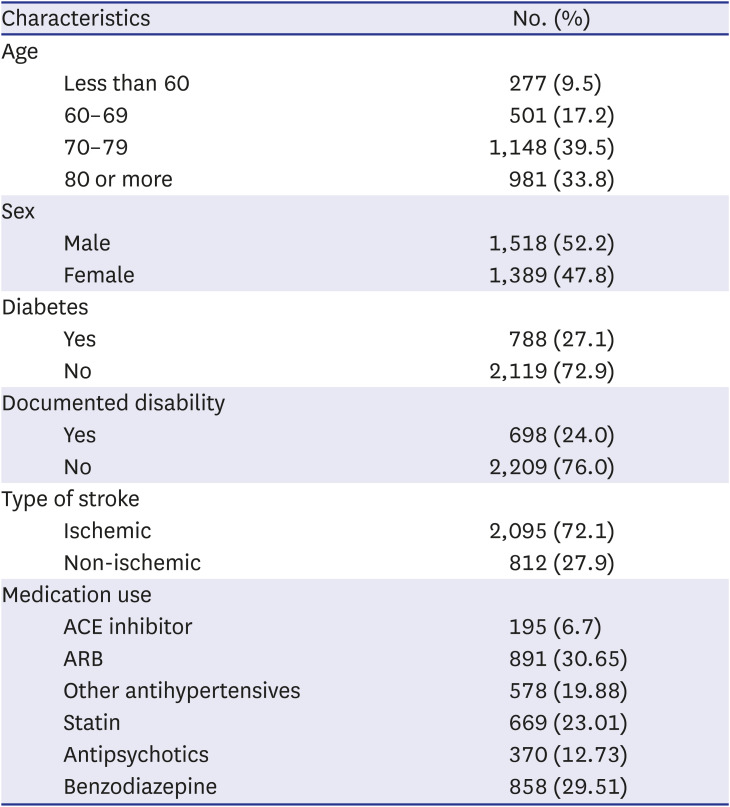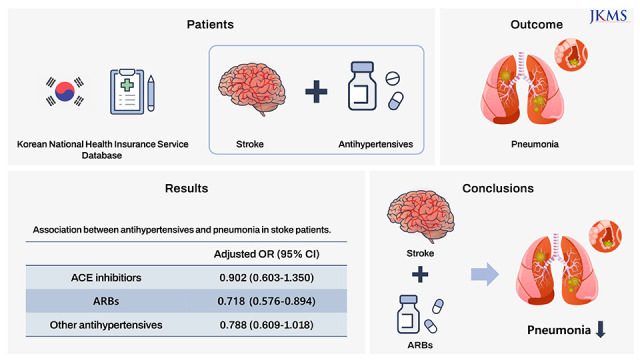1. Ohkubo T, Chapman N, Neal B, Woodward M, Omae T, Chalmers J, et al. Effects of an angiotensin-converting enzyme inhibitor-based regimen on pneumonia risk. Am J Respir Crit Care Med. 2004; 169(9):1041–1045. PMID:
14990394.
2. Statistics Korea. 2020 cause of death statistics. Updated 2021. Accessed February 24, 2022.
http://kosis.kr
.
3. Westendorp WF, Nederkoorn PJ, Vermeij JD, Dijkgraaf MG, van de Beek D. Post-stroke infection: a systematic review and meta-analysis. BMC Neurol. 2011; 11(1):110. PMID:
21933425.
4. Elkind MS, Boehme AK, Smith CJ, Meisel A, Buckwalter MS. Infection as a stroke risk factor and determinant of outcome after stroke. Stroke. 2020; 51(10):3156–3168. PMID:
32897811.
5. Liu CL, Shau WY, Wu CS, Lai MS. Angiotensin-converting enzyme inhibitor/angiotensin II receptor blockers and pneumonia risk among stroke patients. J Hypertens. 2012; 30(11):2223–2229. PMID:
22929610.
6. Lee JS, Chui PY, Ma HM, Auyeung TW, Kng C, Law T, et al. Does low dose angiotensin converting enzyme inhibitor prevent pneumonia in older people with neurologic dysphagia--a randomized placebo-controlled trial. J Am Med Dir Assoc. 2015; 16(8):702–707. PMID:
26123256.
7. Caldeira D, Alarcão J, Vaz-Carneiro A, Costa J. Risk of pneumonia associated with use of angiotensin converting enzyme inhibitors and angiotensin receptor blockers: systematic review and meta-analysis. BMJ. 2012; 345:e4260. PMID:
22786934.
8. Lee J, Lee JS, Park SH, Shin SA, Kim K. Cohort profile: The National Health Insurance Service-National Sample Cohort (NHIS-NSC), South Korea. Int J Epidemiol. 2017; 46(2):e15. PMID:
26822938.
9. Maclure M. The case-crossover design: a method for studying transient effects on the risk of acute events. Am J Epidemiol. 1991; 133(2):144–153. PMID:
1985444.
10. Mandell LA, Niederman MS. Aspiration pneumonia. N Engl J Med. 2019; 380(7):651–663. PMID:
30763196.
11. Herzig SJ, LaSalvia MT, Naidus E, Rothberg MB, Zhou W, Gurwitz JH, et al. Antipsychotics and the risk of aspiration pneumonia in individuals hospitalized for nonpsychiatric conditions: a cohort study. J Am Geriatr Soc. 2017; 65(12):2580–2586. PMID:
29095482.
12. Boivin Z, Perez MF, Atuegwu NC, Metersky M, Alvarez CA, Anzueto A, et al. Association of atypical antipsychotics and mortality for patients hospitalised with pneumonia. ERJ Open Res. 2019; 5(4):00223-2018. PMID:
31720299.
13. Sun GQ, Zhang L, Zhang LN, Wu Z, Hu DF. Benzodiazepines or related drugs and risk of pneumonia: a systematic review and meta-analysis. Int J Geriatr Psychiatry. 2019; 34(4):513–521. PMID:
30623504.
14. Kang JH, Kao LT, Lin HC, Wang TJ, Yang TY. Do outpatient statins and ACEIs/ARBs have synergistic effects in reducing the risk of pneumonia? A population-based case-control study. PLoS One. 2018; 13(6):e0199981. PMID:
29953536.
15. Mortensen EM, Nakashima B, Cornell J, Copeland LA, Pugh MJ, Anzueto A, et al. Population-based study of statins, angiotensin II receptor blockers, and angiotensin-converting enzyme inhibitors on pneumonia-related outcomes. Clin Infect Dis. 2012; 55(11):1466–1473. PMID:
22918991.
16. Shah S, McArthur E, Farag A, Nartey M, Fleet JL, Knoll GA, et al. Risk of hospitalization for community acquired pneumonia with renin-angiotensin blockade in elderly patients: a population-based study. PLoS One. 2014; 9(10):e110165. PMID:
25353172.
17. Kim J, Lee JK, Heo EY, Chung HS, Kim DK. The association of renin-angiotensin system blockades and pneumonia requiring admission in patients with COPD. Int J Chron Obstruct Pulmon Dis. 2016; 11:2159–2166. PMID:
27672320.
18. Lai CC, Wang YH, Wang CY, Wang HC, Yu CJ, Chen L. Comparative effects of angiotensin-converting enzyme inhibitors and angiotensin II receptor blockers on the risk of pneumonia and severe exacerbations in patients with COPD. Int J Chron Obstruct Pulmon Dis. 2018; 13:867–874. PMID:
29563786.
19. Nakayama K, Sekizawa K, Sasaki H. ACE inhibitor and swallowing reflex. Chest. 1998; 113(5):1425.
20. Omboni S, Borghi C. Zofenopril and incidence of cough: a review of published and unpublished data. Ther Clin Risk Manag. 2011; 7:459–471. PMID:
22162922.
21. Barnes RA. Pneumonia and ACE inhibitors--and cough. BMJ. 2012; 345:e4566. PMID:
22786936.
22. Moriya T, Nakayama K, Nakamura S, Mochizuki A, Ofuji T, Shirota T, et al. Enhancement of swallowing motor activity by the ACE inhibitor imidapril in an arterially perfused rat preparation. Eur J Pharmacol. 2019; 861:172601. PMID:
31421086.
23. Hsu WT, Galm BP, Schrank G, Hsu TC, Lee SH, Park JY, et al. Effect of renin-angiotensin-aldosterone system inhibitors on short-term mortality after sepsis: a population-based cohort study. Hypertension. 2020; 75(2):483–491. PMID:
31838905.
24. Lee HY, Ahn J, Park J, Kang CK, Won SH, Kim DW, et al. Different therapeutic associations of renin-angiotensin system inhibitors with coronavirus disease 2019 compared with usual pneumonia. Korean J Intern Med. 2021; 36(3):617–628. PMID:
33858123.
25. Nahmod KA, Nahmod VE, Szvalb AD. Potential mechanisms of AT1 receptor blockers on reducing pneumonia-related mortality. Clin Infect Dis. 2013; 56(8):1193–1194. PMID:
23315319.
26. Tanaka J, Tajima S, Asakawa K, Sakagami T, Moriyama H, Takada T, et al. Preventive effect of irbesartan on bleomycin-induced lung injury in mice. Respir Investig. 2013; 51(2):76–83.
27. van de Garde EM, Souverein PC, Hak E, Deneer VH, van den Bosch JM, Leufkens HG. Angiotensin-converting enzyme inhibitor use and protection against pneumonia in patients with diabetes. J Hypertens. 2007; 25(1):235–239. PMID:
17143196.
28. Valerius NH, Eff C, Hansen NE, Karle H, Nerup J, Søeberg B, et al. Neutrophil and lymphocyte function in patients with diabetes mellitus. Acta Med Scand. 1982; 211(6):463–467. PMID:
6981286.
29. Marhoffer W, Stein M, Maeser E, Federlin K. Impairment of polymorphonuclear leukocyte function and metabolic control of diabetes. Diabetes Care. 1992; 15(2):256–260. PMID:
1547682.
30. Liu CL, Shau WY, Chang CH, Wu CS, Lai MS. Pneumonia risk and use of angiotensin-converting enzyme inhibitors and angiotensin II receptor blockers. J Epidemiol. 2013; 23(5):344–350. PMID:
23912052.
31. van de Garde EM, Souverein PC, van den Bosch JM, Deneer VH, Leufkens HG. Angiotensin-converting enzyme inhibitor use and pneumonia risk in a general population. Eur Respir J. 2006; 27(6):1217–1222. PMID:
16455828.
32. Sekizawa K, Matsui T, Nakagawa T, Nakayama K, Sasaki H. ACE inhibitors and pneumonia. Lancet. 1998; 352(9133):1069.
33. Dublin S, Walker RL, Jackson ML, Nelson JC, Weiss NS, Jackson LA. Angiotensin-converting enzyme inhibitor use and pneumonia risk in community-dwelling older adults: results from a population-based case-control study. Pharmacoepidemiol Drug Saf. 2012; 21(11):1173–1182. PMID:
22949094.
34. Wang HC, Lin CC, Lau CI, Chang A, Kao CH. Angiotensin-converting enzyme inhibitors and bacterial pneumonia in patients with Parkinson disease. Mov Disord. 2015; 30(4):593–596. PMID:
25641619.









 PDF
PDF Citation
Citation Print
Print





 XML Download
XML Download